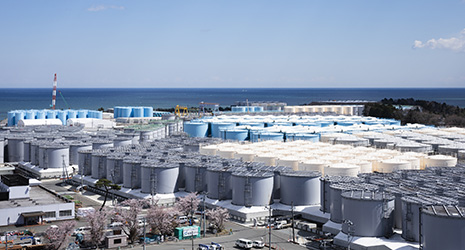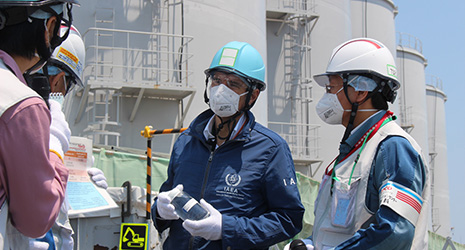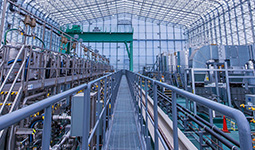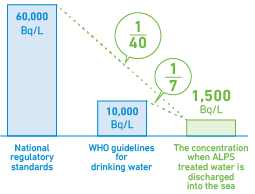October 2022
- English
- 日本語
Ensuring the Safety of Discharging ALPS Treated Water into the Sea

Storage tanks at Fukushima Daiichi NPS 
IAEA Director General Rafael Grossi (center) holding a bottle containing a sample of the ALPS treated water at TEPCO’s Fukushima Daiichi NPS in May 2022

The ALPS (Advanced Liquid Processing System) at Fukushima Daiichi NPS 
Comparison of tritium concentrations

The Government of Japan, under review by the International Atomic Energy Agency (IAEA), is pushing forward with preparations to discharge the ALPS treated water from the Fukushima Daiichi Nuclear Power Station into the sea in a safe and highly transparent manner in accordance with international safety standards.

The Great East Japan Earthquake of March 11, 2011 caused extensive damage from the tsunami, especially along the Pacific coast of the Tohoku region. At Tokyo Electric Power Company Holdings (TEPCO) Fukushima Daiichi Nuclear Power Station (hereinafter, “Fukushima Daiichi NPS”) in Fukushima Prefecture, the cooling system for the reactors was shut down, causing the three reactors that were in operation to reach high temperatures and melt fuel. Hydrogen gas was generated, and it caused a hydrogen explosion, releasing radioactive materials into the environment. After the explosion, countermeasures taken including the cooling of reactors resulted in a sharp decline in the amount of radioactive materials released, and the reactors were placed in “cold shutdown” status in December of that year. To date, the amount of radioactive materials released has remained at a level that has had virtually no environmental impact.
Nevertheless, water continues to be injected into the reactors to cool the “fuel debris,” which is melted fuel mixed with structural materials that have solidified. Water that comes in contact with fuel debris becomes contaminated water containing high concentrations of radioactive materials, which then mix with groundwater and rainwater that flows into the reactor buildings, generating new contaminated water. In response, TEPCO has been taking measures such as installing impermeable walls and pumping up groundwater. However, it is difficult to immediately stop the generation of new contaminated water, and more than 1,000 tanks are expected to be full by fall 2023. Although TEPCO is currently conducting decommissioning work with various tasks at the Fukushima Daiichi NPS, there are concerns about the lack of space to build the facilities needed for future decommissioning work due to the storage tanks occupying the site, as well as concerns about the risk of the tanks leaking in the event of a disaster. Therefore, eliminating the tanks by disposing of the ALPS treated water, in which radioactive materials other than tritium are purified from the contaminated water by ALPS (Advanced Liquid Processing System) until it meets regulatory standards, has become a crucial task for the decommissioning of Fukushima Daiichi NPS and reconstruction of Fukushima. In April 2021, after more than six years of deliberation, the Government of Japan announced its policy of discharging ALPS treated water into the sea, taking into consideration the precedents both in Japan and overseas as well as ease of monitoring.

Safety of Discharge into the Sea
In the case of discharging into the sea, concerns have been raised about the presence of tritium in ALPS treated water. Tritium is a radioactive material present in all water on earth, including rainwater, seawater, and tap water, as well as in the human body. Since tritium bonds with oxygen to form a liquid with virtually identical properties as water, it is extremely difficult to separate tritium alone from water. No technology that can be applied to the removal of tritium from water currently exists. However, the radiation energy emitted by tritium is very weak and if tritium were to enter the human body, it is not expected to accumulate. Actually, water containing tritium is generated at nuclear facilities around the world, and each facility discharges it in compliance with safety standards. No effects caused by tritium have been observed in the vicinity of these facilities.
The ALPS treated water from the Fukushima Daiichi NPS will be diluted with seawater before being discharged into the sea, up to the pre-accident discharge control target of 22 trillion Bq (becquerels) per year. The designated concentration of tritium will be 1,500 Bq per liter. This is 1/40th of the Japanese safety standard and 1/7th of the World Health Organization (WHO) guidelines for drinking-water quality. The Government of Japan evaluated that the impact on the human body and the environment from the discharge of the ALPS treated water into the sea is significantly small even compared to the impact from natural sources.

In addition, the Government of Japan has requested assistance from the International Atomic Energy Agency (IAEA) to ensure that the ALPS treated water is discharged into the sea in a safe and highly transparent manner in accordance with international safety standards. The IAEA has accepted the request and is conducting a rigorous review of the safety-related aspects of the entire process from before to after the discharge of ALPS treated water. The first review was conducted in February 2022, and 15 Task Force members, consisting of the IAEA secretariat and experts from eight countries, including the United States, the United Kingdom, China, South Korea, and Russia, visited Japan. They held discussions with the government and TEPCO, and visited the Fukushima Daiichi NPS. The report on the mission was released in April of that year, and the Task Force noted that TEPCO had successfully incorporated prevention measures in the design of the ALPS treated water facility as well as in the associated operating procedures. The Task Force further noted that the effect on humans from the ALPS treated water being discharged into the sea is expected to be significantly below the dose constraint designated by Japan in accordance with international safety standards and so on.
In May 2022, Rafael Grossi, Director General of the IAEA, visited the Fukushima Daiichi NPS. Following the visit, Director General Grossi made the following comment, “We, as the IAEA, will be able to ascertain that once the discharge of processed water goes into the Pacific Ocean, it will be done in full conformity with the international standards, and therefore it will not cause any harm to the environment.”
In order to ensure rigorous transparency, IAEA laboratories and third-country research institutes take part in marine monitoring from before to the completion of discharge, and local government officials and fisheries workers also have the opportunity to see the monitoring.
(For more information on the ALPS treated water, see https://www.meti.go.jp/english/earthquake/nuclear/decommissioning/atw.html).
Note: This article was written with the consent of the Ministry of Economy, Trade and Industry and on the basis of publicly available data from the Ministry.

